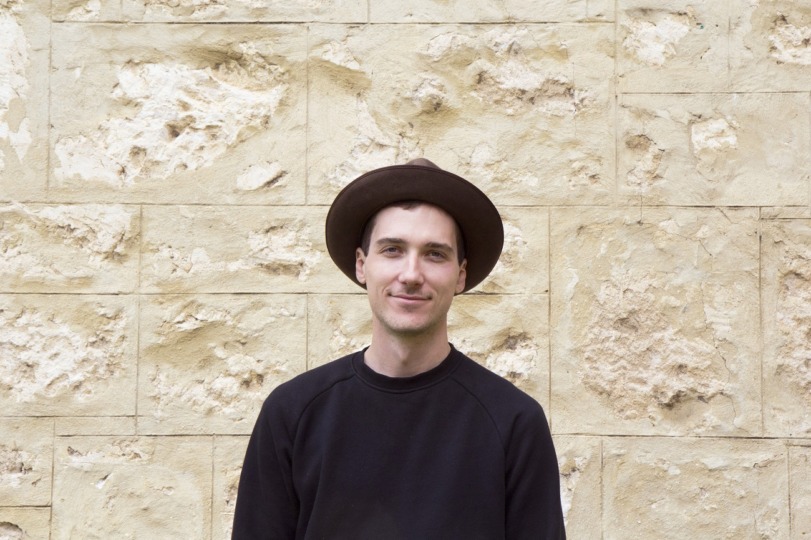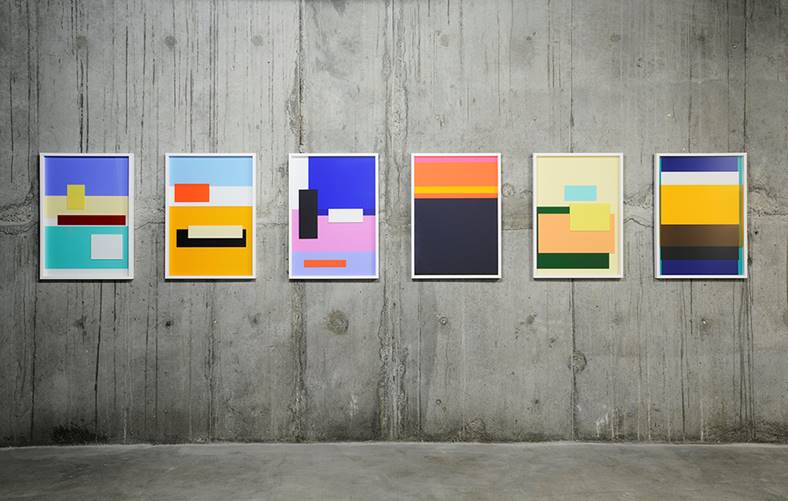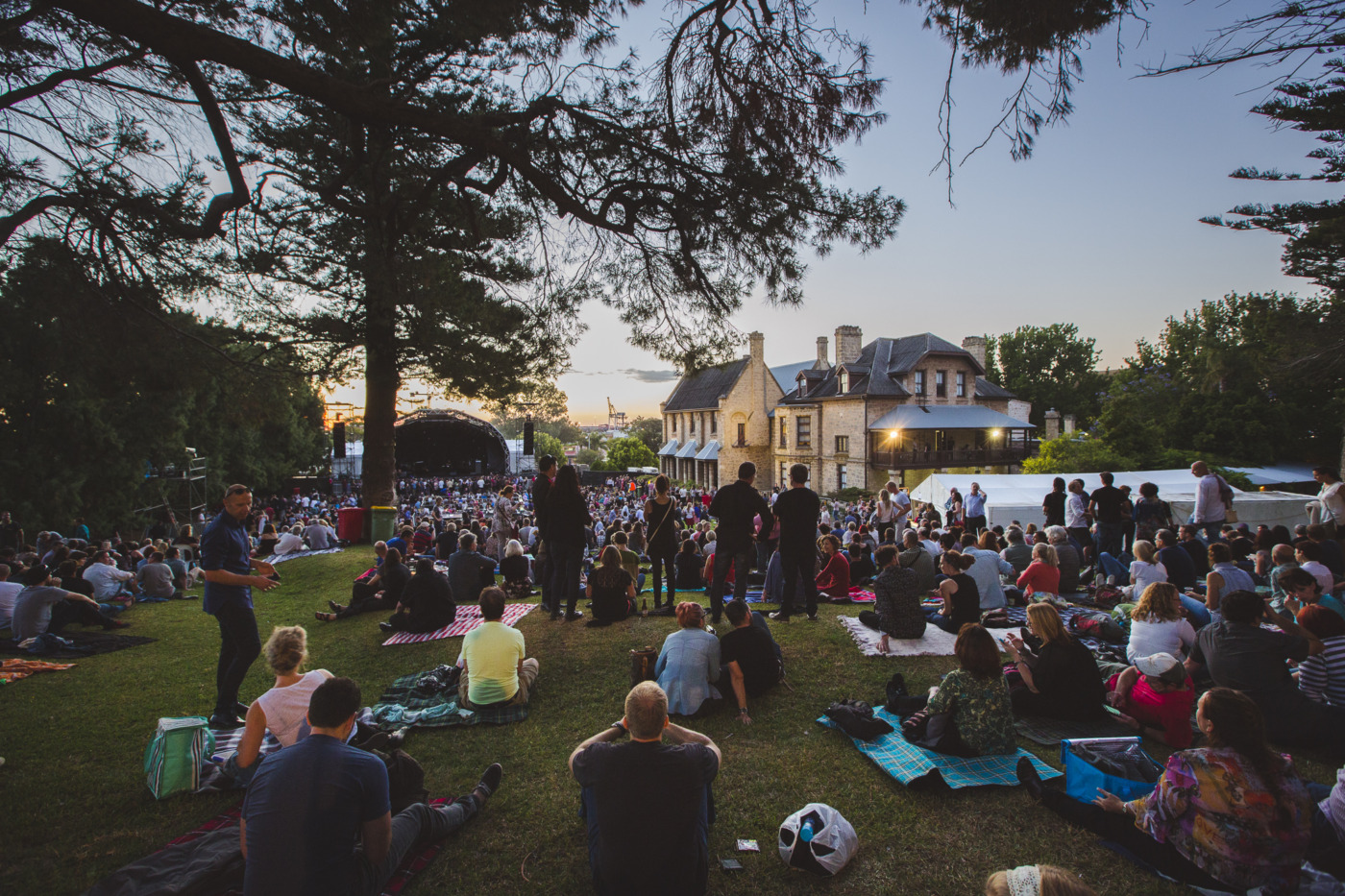Fremantle-based artist Dan McCabe has been selected as the WA participant in the 2018 FAC-Art Ichol Artist in Residence Exchange Program. He will travel to India for a month long residency at the esteemed multi-arts organisation Art Ichol in September.
McCabe, a multi-disciplinary visual artist, explores social, environmental and political challenges facing different communities all over the world in his practice. Working across sculpture, photography, video and installations, McCabe’s recent projects have looked at various concepts including housing affordability, doomsday ideologies, contemporary spirituality and the integration of AI technology into everyday life.
“It is very exciting to be selected for the Art Ichol residency, it’s a really unique opportunity to spend a month in a small, rural community in one of the most densely populated countries in the world,” said McCabe. “I can’t wait to meet people who live and work in the area, source local materials and create works which respond to these experiences and the landscape.”
Art Ichol is in Maihar, a rural city in the state of Madhya Pradesh, and offers a unique living and working experience to visiting artists through its diverse Artists in Residence program. Artists have access to extensive studio and workshop spaces, including a bronze casting foundry, stone and wood carving workshop, ceramic centre, painter’s studio, graphic studio and an art gallery workshop.
“After the success of last year’s inaugural exchange, we’re so excited to continue our relationship with an institution as well respected as Art Ichol,” said FAC Director Jim Cathcart. “The residency at Art Ichol offers WA artists a really fantastic opportunity to further their practice, develop new skills and meet some truly amazing artists.”
A selected Indian artist will carry out a reciprocal residency at Fremantle Arts Centre later this year.
This program expands on FAC’s long running annual exchange with Taipei Culture Foundation (Taiwan), supported by Asialink, a Melbourne-based arts and business networking organisation.
Almost 25 years ago, Fremantle Arts Centre presented the ground breaking exhibition Bush Women: Fresh Art from Remote WA, the first showcase of works by WA Aboriginal artists from the Kimberley region and the Ngaanyatjarra Lands of the Western Desert. Now Bush Women: 25 Years On reassembles the works of Paji Honeychild Yankkarr, Daisy Andrews, Queenie McKenzie (Gara-Gara), Tjapartji Kanytjuri Bates, Tjingapa Davies and Pantjiti Mary McLean a quarter of a century later.
Bush Women was originally shown in 1994 and marked a significant moment in WA art history, highlighting the practices of senior female Aboriginal artists from remote parts of the state for the first time.
The collection of paintings, some of which were created at FAC during artist residencies, showcased a wide, varied and often surprising style of works. The exhibition’s original curator John Kean said “Bush Women tapped into a dynamic moment, as the expressive trends, that would reach their zenith in the new millennium, were emerging.”
“Painting materialised as a mercurial process in which the lived experience of the artist was imparted through gesture. The authority with which such paintings were composed was expressed through open forms and assured mark making,” he said.
Each artist went on to gain considerable critical recognition across Australia and beyond, with two thirds of the works acquired by institutions like the National Gallery of Australia and highly regarded collectors including Janet Holmes à Court.
“Bush Women: 25 Years On celebrates an important part of WA’s art history, a moment in the early 1990s dominated by Aboriginal women artists from remote Australia,” said FAC Special Projects Curator Erin Coates. “Restaging this exhibition has been part of a larger undertaking at Fremantle Arts Centre to rediscover our own exhibition history and in doing so to better understand the role FAC has played in shaping and supporting the careers of WA artists.”
This exhibition is a first for Fremantle Arts Centre, an ambitious project that uses archived material to understand the role the organisation has played in supporting creative practices and bringing national attention to WA artists.
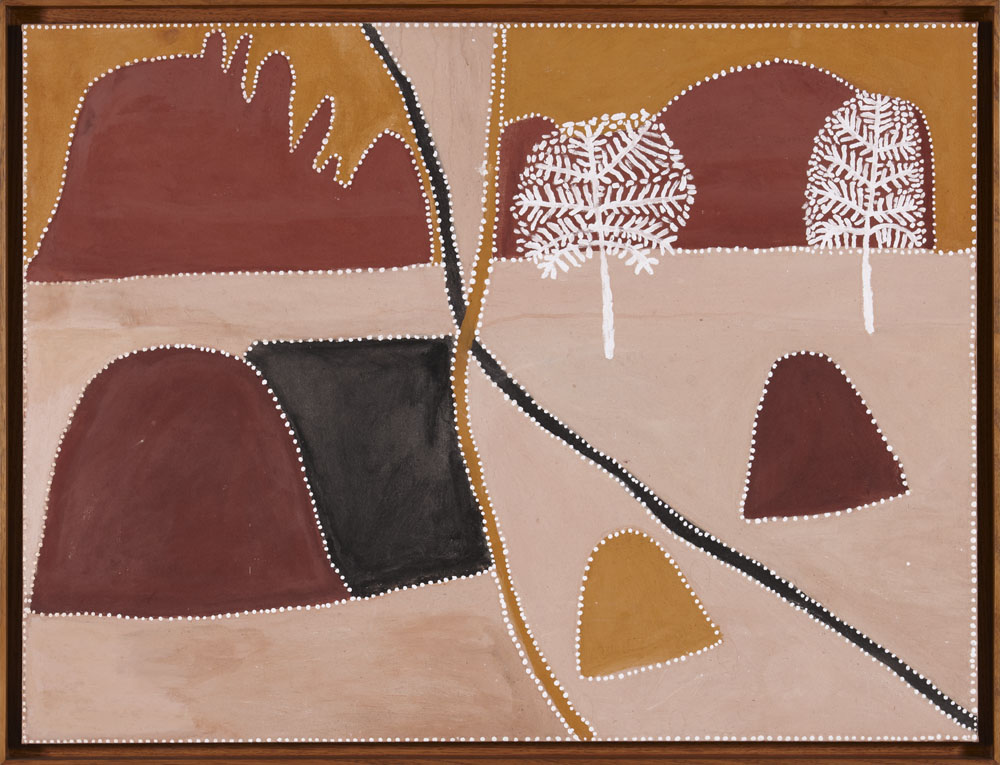
Queenie McKenzie (Gara-Gara), Garloomboomy, Ngamany the Borders of Gija Country, c.1992, ochre on canvas, 96 x 126cm. Artbank Collection, purchased 1994
Artist Biographies
Daisy Andrews (c1934)
Andrews grew up at Cherrabun Station, where her father worked. Sometimes he would run away with his kids and three wives, but would always be picked up by the police, who returned him to the station. Andrews began working there too, cleaning and cooking in return for tea, flour, sugar, tobacco, blankets and clothes. She began painting at the Karrayili Adult Education Centre in Fitzroy Crossing and was represented by Mangkaja Arts. Andrews uses the conventions of perspective associated with the western landscape. Her view of Country is formed by ngarrankanyi (Dreaming), alongside post-contact memories of the massacres of her people and their painful experience with the newly arrived kartiya (Europeans). Her work is made in memory of the way that the landscape is charged with simultaneously personal and cultural memory.
Paji Honeychild Yankkarr (c1912)
Paji Honeychild Yankkarr grew up in the Western Desert, where she married her first husband. After his death and initial trepidation about nearing the kartiya (Europeans), Yankkarr found work at Cherrabun Station washing clothes, watering the garden, cooking at the stock camp and even cutting the lawn with scissors. Yankkarr’s second husband was Boxer Andrews, an artist from Fitzroy Crossing and Daisy Andrews’ brother. Yankkarr began painting later in life at the Karrayili Adult Education Centre in Fitzroy Crossing. She was represented by Mangkaja Arts. Her paintings focus on waterholes, the vital and changing lifeblood of the region. Where concentric circles of dots serve to signify waterholes in traditional paintings, Yankkar’s forms are brightly coloured, made with almost wild gestures and provide a sense of the ‘living’ water and soakages. She takes an elevated viewpoint, her free brushstrokes map out the vitality lent by the water to the surrounding land, whilst always remaining tactile.
Queenie McKenzie (Gara-Gara) (1922 -1998)
Queenie McKenzie (Gara-Gara) worked as a cook on Texas Downs Stations in her early life and spent the whole of her life in the station country of the Eastern Kimberley. Here, the artist married Charlie McKenzie. At one time, the police tried to take her away to Turkey Creek, as was the general policy for mixed-race children, but her mother argued strongly and ultimately successfully for her to stay. When the station eventually changed hands, all Aboriginal people were blocked from accessing their ancestral lands where the station stood. McKenzie has been a leader in the struggle for access to that land for her family and community, even attending the State Parliament in Perth to defend this right. She and Jimmy had no children, but McKenzie was instrumental in ‘growing up’ several adopted kids, and later their grandchildren. Her paintings relate to the rugged topography of the Warmun region and the iconography of the ceremonies during the late 1970s. That land, which she was for many years forced to paint from a distance, was marked by the roads and buildings of the mining and pastoral industries. McKenzie constructs her landscapes laterally with runs of hills and ridges approaching a horizon. Key landmarks are highly stylised and the ochres she selects to render each hill or tree reinforce their symbolic meaning. Her paintings represent the complex reality of European occupation of ancestral lands – introduced land uses and settlements co-existing with Aboriginal people, Law and traditions. By the 1990s, McKenzie represented the only significant female voice coming out of Warmun, which was for the most part male. McKenzie adopted the common schematic of a large area of monochromatic colour bounded by white dots, though her own take on this is to have a more open, more firmly divided (agency) plane than her peers.
Tjapartji Kanytjuri Bates (c1931)
Tjapartji Kanytjuri Bates grew up with her father, siblings and cousins and travelled the country east and north of Warburton. She visited Wanarn, Karrnka, Mantamarru and Wirlkurral and lived for a time in Kalgoorlie. Bates began painting in the early 1990s with the Warburton Arts Project. Much of Bates’ work describes the Tjukurrpa (Dreaming). Her works are bold and she is known for painting by working both in from the edges and out from the centre to create a vibrant, elastic surface. She uses powerful, thick lines that relate to the application of ceremonial body paint. Bates also uses classical desert symbols, like the ‘U’ shape for a seated figure and simplified images for tools and footprints to imply a narrative over time.
Pantjiti Mary McLean (c1935)
Pantjiti Mary McLean grew up to the west of Yularu on the NT/WA border. She ran away from this area in late adolescence, when her uncle returned from a journey riding a camel, which frightened her. At Blackstone, she met her husband Mr Bates, and they moved to Mount Margaret Mission where her children were raised and she worked at the sheep station. She took up painting and wood carving later in life, after moving to Ninga Mia (in Kalgoorlie). Throughout the 1990s she worked extensively with artist Nalda Searles as part of the Healthway Fringe Camp Project to develop her distinctive painterly style. She began painting in her 50s, creating sprawling narrative tableaux populated with animated figures, symbols, gestures and activity of everyday life. McLean’s paintings depict episodic evocations from her childhood, which unfold across multiple canvasses. While figures in desert painting were not new, the volume of them in McLean’s painting (up to 70 figures in one painting), as well as the emphasis on their fleeting, human gestures are remarkable and radical.
Media Contact
Liz Walker – lizw@fremantle.wa.gov.au | 08 9432 9565
Fremantle Arts Centre and Art Ichol are pleased to announce the renewal of their partnership giving Western Australian and Indian artists the opportunity to engage in an Artist in Residence Exchange Program. FAC will select one WA artist to travel to the rural city of Maihar in Madhya Pradesh, India to live and work at Art Ichol for one month during September to mid-October 2018.
Art Ichol is a multi-faceted arts organisation that hosts national and international artists in a diverse artist in residence program. Consisting of three estates, The Art Ichol Skill Centre, The
Maihar Heritage Home and Amaria ~ The Writer’s Retreat, Art Ichol offers a unique living and working experience.
Art Ichol’s facilities include studio spaces, living quarters, an art gallery, bronze casting foundry, open-air sculpture park, stone and wood carving workshop, ceramic and pottery centre, painter’s studio, clay modelling room, graphic studio and an art café.
“We’re thrilled to be partnering with Art Ichol again this year. The organisation is known for its’ innovative residency program and strong creative culture. The Artist in Residence Exchange Program offers artists an opportunity to develop their practice, explore a part of Indian culture and use studios and facilities that they might not have access to otherwise,” said FAC Director Jim Cathcart.
Apply now
Applications for the 201 8 Fremantle Arts Centre & Art Ichol Artist in Residence Exchange Program are now open and FAC invites WA artists to apply.
8 Fremantle Arts Centre & Art Ichol Artist in Residence Exchange Program are now open and FAC invites WA artists to apply.
The successful applicant will receive a return airfare between Perth and India (including airport transfers from the Indian airport), independent living quarters, three meals a day, laundry and
WiFi facilities, an independent workspace (including a quantified supply of working materials) and access to Art Ichol’s shared workshops and studios.
Only artists whose primary place of residence and work is located within WA are eligible to apply.
Download the application pack
Applications close COB Friday 6 July 2018.
For more information about Art Ichol Maihar visit http://artichol.in/
For further information about the 2018 Fremantle Arts Centre & Art Ichol AIR Exchange Program or to apply, contact FAC AIR Coordinator Bevan Honey at bevanh@fremantle.wa.gov.au
Applications must be made to Fremantle Arts Centre.
Returning to Fremantle Arts Centre in 2018, Revealed is an annual program that provides development opportunities and exposure for new and emerging artists from WA Aboriginal art centres across the state. Comprised of an art market, exhibition, artist talks and film night, Revealed’s program showcases the incredible talent and output of contemporary artists throughout our diverse state. In addition to the public events, Revealed also offers a comprehensive professional development program for Aboriginal artists and art centre staff.
“Revealed showcases the best new art being made by emerging Aboriginal artists across WA; from the most remote communities right through to metropolitan studios,” said FAC Exhibitions and Special Projects Coordinator, Erin Coates. “What’s more, this is a chance for audiences to directly engage with the artists by hearing them share stories at Artists in Conversation and buying work directly from them at the Art Market and Exhibition. Revealed celebrates diverse, emergent and experimental practices by Aboriginal artists from across our state and is the premier event for experiencing the extraordinary range of new work by these artists.”
Revealed is an initiative of the WA State Government through the Department of Local Government, Sport and Cultural Industries; and the Australian Government through the Indigenous Visual Arts Industry Support program.
Revealed Film Night: Sweet Country
Wed 4 Apr | 7pm | Doors 6pm
Tickets $15 from fac.org.au
Revealed: Aboriginal Artists in Conversation
Fri 6 Apr | 10am–12pm | Free
Revealed Exhibition: New & Emerging WA Aboriginal Artists
Opening Fri 6 Apr | 6:30pm | Exhibition
Runs Sat 7 Apr – Sun 20 May | Free
Revealed WA Aboriginal Art Market
Sat 7 Apr | 10am–5pm | Free Entry
For details about all Revealed events visit fac.org.au
Australia’s richest and most prestigious print award returns in 2018 with $22,000 in prize money. The Fremantle Arts Centre Print Award supported by Little Creatures Brewing is Australia’s premier showcase of prints and artists’ books.
Running for more than 40 years, the award and exhibition continue to present the best works from established, emerging and cross-disciplinary artists.
First Prize: $16,000
Second Prize: $6,000
Entries for the 2018 FAC Print Award are now open
Enter by 5pm, Fri 18 May.
The winner(s) will be announced at the exhibition opening 6:30pm Thu 13 Sep | Exhibition runs Fri 14 Sep – Sun 4 Nov
Online entries only. Please call 08 9432 9555 with queries.
The latest edition of the FAC What’s On has hit the streets. Find out all about the upcoming exhibitions, events and courses happening between October and December 2017.
Highlights include:
- In Cahoots: artists collaborate across Country
- The In Cahoots exhibition workshops
- Tash Sultana
- Sunday Music
- Mission Songs
- Bazaar
http://issuu.com/fremantleartscentre/docs/wo_2017_q4_issuu?e=2557115/54195196
Midnight Oil have added a special benefit concert at FAC to their current Australian tour, presented by Frontier Touring.
One For The Oceans will see the band play their iconic album 10, 9, 8, 7, 6, 5, 4, 3, 2, 1 in its entirety for the first time ever in this country, along with an hour of other Oils classics.
The 10 – 1 album – as it’s typically called – took Midnight Oil to a whole new level after it landed in 1982. An utterly original piece of work featuring songs like US Forces, Power & The Passion, Read About It and Short Memory it stayed on the Australian charts for 171 weeks after its release.
This one-off gig will happen in the intimate setting of our South Lawn on Sunday 29 October. Every cent of profit from the show will go to various charities that work in the areas of reef protection and climate change including AMCS.org.au.
The Oils will be supported by special guests POW! Negro, a local Fremantle six-piece.
City of Fremantle Mayor Brad Pettitt said: “Midnight Oil’s decision to play a unique concert right here at WA’s favourite Arts Centre is further evidence that Fremantle truly is WA’s event capital. The cause is one that’s very important to Fremantle so we’re thrilled to support it. This will be a gig to remember.”
Tickets go on sale 10am Wed 18 Oct from fac.oztix.com.au. There will be a limit of 6 tickets per person.
The show will be staged with the support of official media partners Fremantle Festival, Mix 94.5 and The West Australian.
Emerging Sydney artist Evan Pank has taken the coveted first prize in this year’s Fremantle Arts Centre Print Award supported by Little Creatures Brewing, the richest and most prestigious printmaking award in Australia, for his work Keeping the Bastards Honest.
He takes out $16,000 in prize money and his print will be acquired by the City of Fremantle Art Collection. Combining screen printing and spray painting techniques, Keeping the Bastards Honest depicts the chaos and emotion of a football riot.
Evan Pank is a young artist whose work explores the influence of sport and fan culture in Australian society and politics. This was the first time he had entered the FAC Print Award. “I entered because I really wanted to reach a new audience,” Pank said. “I was ecstatic just to be named a finalist so it definitely hasn’t sunk in yet that I actually won!”
His win continues the Award’s history of recognising the work of early-career artists. This year’s judging panel – Rebecca Beardmore (NSW), André Lipscombe (WA) and Franchesca Cubillo (ACT) – praised the work for “making viewers aware of their own spectatorship, demanding the act of looking which results in deep and continual engagement.”
“The work presents the boundary between the festive and the fight in the apparent hostility unleashed by the crowd, making reference to the patriarchal fog and tribal culture of team sport,” they said.
“The images, sampled from various print sources are tied together in a suggestive fashion, heightening the intensity of gesture and reducing its politicised agency to mere spectacle and display.”
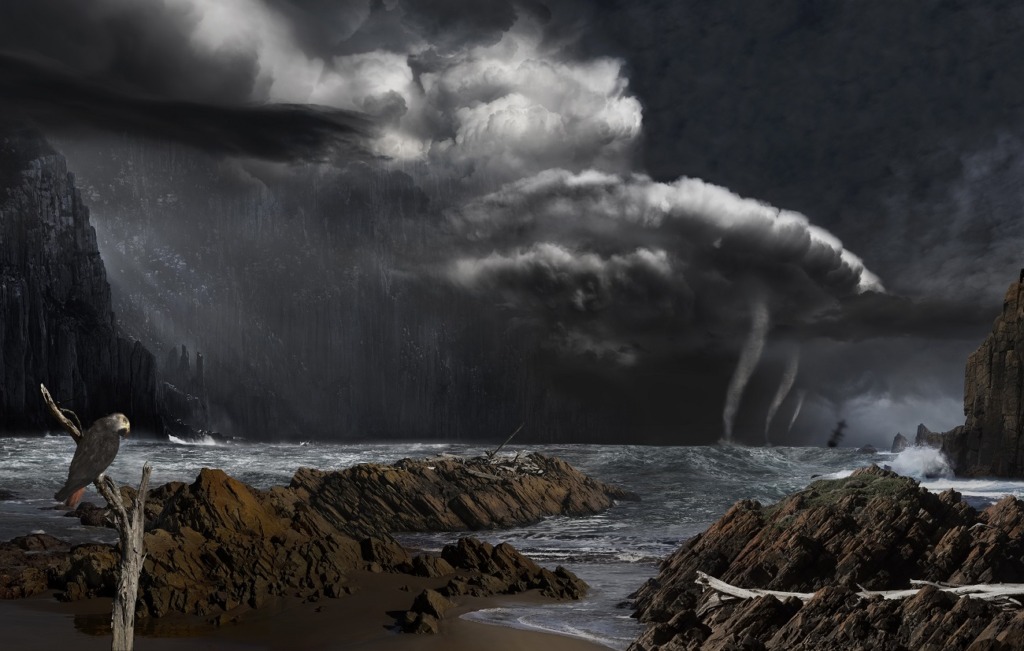
Valerie Sparks, Prospero’s Island South West, 2016, pigment inkjet print on paper, 140×220cm. Printed by JCP
Melbourne artist Valerie Sparks was awarded second prize and $6,000 for Prospero’s Island South West, a digitally printed, moody montage creating an image of a wild dark sea, night sky and sailing ship which seems to reference grand narrative historical painting.
Sparks, known for her beautiful, technically superb composite images of the natural world, has been selected for exhibition in the FAC Print Award previously and won the 2009 People’s Choice Award.
“The juxtaposition and play between areas of light and dark are both frightening and alluring,” said the judges. “In reference to the capture of historical narratives in painting is the dark acknowledgement of the ongoing trauma of the Aboriginal peoples and natural systems impacted upon following the arrival of the white man.”
HIGHLY COMMENDED
Artists Nathan Beard (WA), David Frazer (VIC), Richard Lewer (VIC) and Andrew HC McDonald (WA) were also highly commended by the judges.
The 56 finalists’ works can be viewed in the exhibition. The judges said this year’s show “offers a diverse mix of highly sophisticated, quality prints that showcase the breadth and complexity of contemporary print practice in Australia.”
The exhibition runs until Sunday 12 November.
We’re very excited that local makers Beau Est Mien are launching their latest collection Sunny Cities at FOUND on Saturday 9 September. Ahead of the big product drop, we caught up with Beau Est Mien’s Johanna Acs and Alina Tang to get the scoop on the new range.
For those who aren’t familiar with Beau Est Mien, tell us about the company. How did it start and what do you do?
Beau Est Mien means ‘beautiful is mine’ and the company started in artist Magali Dincher’s sunny courtyard studio in Hamilton Hill. Since then we have grown to become a local printmaking studio designing beautiful stationery and gifts, run by a cute and diverse group of girls. Everything we create begins with original handmade artworks from which the product designs stem, resulting in a colourful and handmade feel. We love our local creative community, so it’s no surprise that we prefer to keep the production of our collections in Australia.
What inspired the new range Sunny Cities?
Sunny Cities aims to portray the most colourful and vibrant bits and pieces of Australia in a collection of bright and unique products. To begin with, we created designs inspired by our home Perth as well as Melbourne and Sydney, though we are very keen to add more cities to the collection in the future! Ultimately, we really just want to give our customers a beautiful piece of Australia to keep at home, or share with friends and family overseas!
Why did you choose to launch the range at FOUND?
FOUND is an incredibly well-curated and welcoming home for Australian artists and makers, and we have been proud to have had our artworks and products stocked there for many years. Not only is FOUND located in a beautiful and historic building, but in our former home and one of our favourite places in the world, Fremantle.
What’s next for the Beau Est Mien team?
Here at Beau Est Mien we are constantly dreaming about and working on exciting new projects. Following the launch of Sunny Cities we have a number of major events including the Finders Keepers market in Melbourne, The Big Design Market in Sydney, and of course the FAC Bazaar in December. We’re also very excited to potentially add more designs to our Sunny Cities range, so that we can celebrate more of Australia. It’s going to be a very busy year for us!
Sunny Cities Launch
Sat 9 Sep | 12–3pm | Free
Triple j favourite and one of Australia’s fastest rising stars, Tash Sultana returns home with a handful of her biggest shows to date. Sailing in the wake of her recently sold-out world tour, her FAC show on Thursday 7 December will be the last chance to witness her mercurial talents until the end of 2018, as Tash bunkers down to write and record her debut album.
Moving through arena sized venues, Tash will be joined by like-minded strummers the Pierce Brothers and tropical rave pop duo Willow Beats for a celebration of instrumental virtuosity.
Tash has spent the last 18 months collecting fans and selling out shows worldwide in a whirlwind of activity. Riding high on the back of her singles Jungle, Notion and Murder To The Mind, the accolades have come thick and fast.
She landed the number 3 slot in last year’s triple j Hottest 100, picked up the Unearthed J Award, hit the top 10 of the ARIA chart with her EP Notion, exceeded gold sales for her single Jungle and has watched the view count on her YouTube channel rocket into the millions.
These standalone performances will serve as a benchmark to just how much Tash has achieved since she was first discovered busking in Melbourne’s CBD. Solo on the stage, as she was on the street, she has a rare ability to create wholly intimate atmospheres, even in the largest of spaces. A diminutive figure equipped with searing confidence and incredible skill, Tash utilises her self-taught skills on over 15 instruments to compliment her powerfully exotic voice and build an intoxicating on-stage atmosphere.
Sign up to exclusive pre-sale tickets before they go on sale to the public on 10am AWST, Friday 28 July from fac.org.au. Pre-sale tickets are on sale from 10am AWST, Thursday 27 July.
